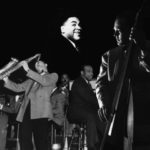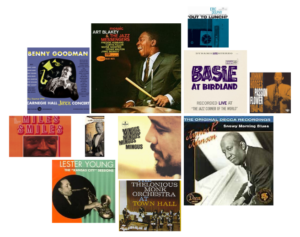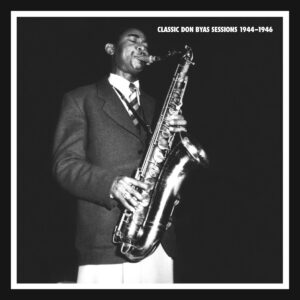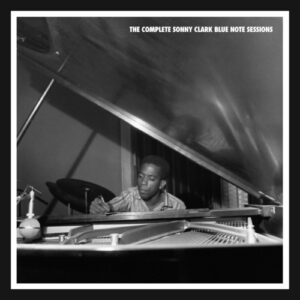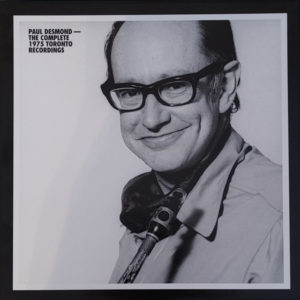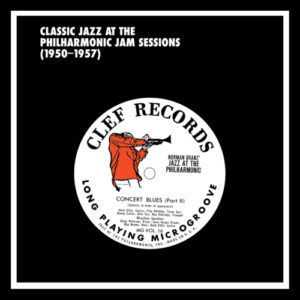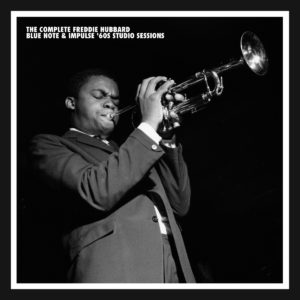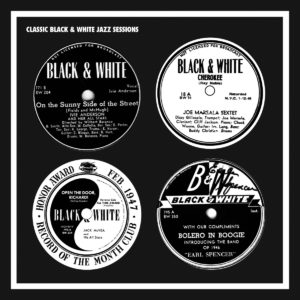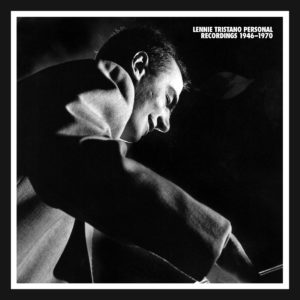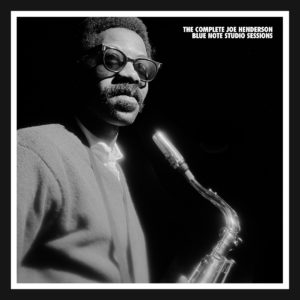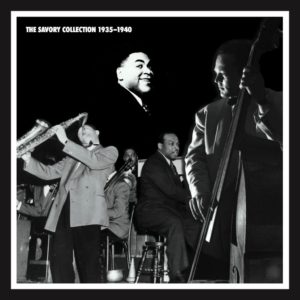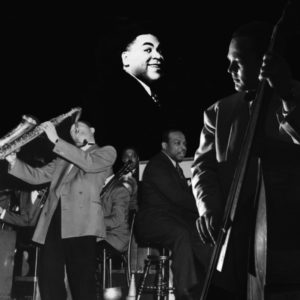Elvin Jones
"How is it that Elvin can play just quarter notes on the whole drum set with both hands and feet in unison as he might do at times for several choruses and light up the stage and entire audience?" - Dave Liebman
Elvin Jones
By Dave Liebman
I would venture to say that most jazz musicians of a certain generation would place Elvin Jones among their favorite all-time artists. Obviously this is for musical reasons, but I think it is equally about charisma, an undeniable presence that Elvin Jones has brought to the music. Some of the words one might use to describe him are joy, strength, intensity, focus, commitment and love.
In fact, when musicians speak about Elvin Jones, it seems the rhetoric elevates to another level of awe and respect. Not to mention that he is probably playing on more than a few of anyone’s “desert island” list of indispensable recordings.
How is it that Elvin Jones can play just quarter notes on the whole drum set with both hands and feet in unison as he might do at times for several choruses and light up the stage and entire audience? Even the casual listener is drawn into his vortex and aura. One only has to look at the expression on his face, the sheer joy and light he spreads with that famous grin of his to realize that this is one very special human being with a power that reaches far beyond the music itself.
Elvin Jones
Live At The Lighthouse
Fancy Free
David Liebman (fl-1,ss-2,ts-3), Steve Grossman (ss-4,ts-5), Gene Perla (b), Elvin Jones (d).- September, 1972
As I wrote in the original liner notes for the 1990 re-release of all the evening’s music, this live recording still is discussed among musicians, especially saxophonists, to this day. What is represented here are two of the early post-Coltrane generation saxophonists spewing out that vocabulary virtually uncensored with a giant green light of approval and support given from the Man himself along with a bassist who loved his role.
The truth is obvious in the music — each of us was doing what we loved, accompanied by three other brothers with whom we probably would’ve gone down in a sinking ship if necessary! It was and remains a special period for me. Recorded on Elvin Jones’s 45th birthday at the end of a three week engagement at this famous club on Hermosa Beach near Los Angeles, Live at the Lighthouse captures a good night, representative of the repertoire as well as intensity which we attained.
The Live at the Lighthouse date was one of the most exciting nights of my musical life. The energy and enthusiasm of a working band consisting of three young musicians with one of the greatest masters of all time was for all of us a once in a lifetime event that we will never forget. It’s fantastic that it was captured tape.
The Artistry of Elvin Jones
For the sake of clarity I am going to describe Elvin Jones’s style in terms of a three part metaphor because I think it nicely summarizes the artistic process. The HAND refers to how an artist technically plays; the HEAD to the actual musical concepts which provide a basis for one’s style; the HEART is the emotional and psychological milieu which frames an artist’s vision. (Another way to conceptualize this threesome is body, mind and spirit.)
The Hand
When drummers describe Elvin Jones’s style, as they admit, words fall short. In general, the way Jones plays seems to be beyond analysis. It is equally difficult to pinpoint antecedents to his concepts. With other drummers, it seems easier to say that so and so evolved from this or that major voice on the instrument, or is linked to a particular stylistic period. Not so with Elvin Jones. Of course, there are obvious physical attributes which he possesses. For example, he has large hands and long limbs enabling him to have a very circular approach as opposed to a more stationary posture. His basic body movement emanates from the back and waist. Nothing is rigid; everything is in motion, producing a flowing, legato style.
When Elvin Jones plays, there is a balance between opposites, meaning a strong and centered beat, yet with an unparalleled looseness. A marked fluidity and continuity between his hands and feet is clearly observable. Also his strokes, both from the arms and legs, appear to be thrown at the drums resulting in a kind of rebounding motion which looks like his whole body is recoiling off the instrument. Then there is the golden touch that drummer Adam Nussbaum describes as if Elvin Jones is striking fine crystal rather than brass when he “tips” on the cymbal. The Elvin Jones ride beat can be light as a feather or bashing. He holds the sticks extremely loose in both hands. On the cymbal, the sticks often bounce high off after the stroke. The left hand “patter” on the snare drum which constantly percolates under the cymbal beat at a low-to-medium volume can be raised in a split second to a very loud single stroke attack. The same dynamic range is true for Elvin Jones’ brush and mallet work.
On brushes he can caress the snare surface so lightly that the beat is hardly discernible. On the other hand, the range of strokes he possesses on the snare and toms with the brushes is tremendous. For certain dynamics, the brushes remain quite close in proximity to the drum producing a dark sound. For more intense percussive strokes, he holds them in a pronounced horizontal plane and strikes the drum where the rubber handle and wires meet. On mallets, which he tends to use more often than other drummers, his range of dynamics from a soft roll to thunderous cascades on the tom-toms are part and parcel of Elvin Jones’ playing. This is especially true at the finale of a ballad under a horn cadenza which usually segues into the last chord. In fact, some of Elvin Jones’ ending cadences after the last note has been played can be longer and more thunderous than other drummer’s full solos!!
What this adds up to is an incredible ability to tread lightly or strike forcefully throughout the drum kit at a moment’s notice. Elvin Jones’ natural physical attributes and sensitive ear have enabled him to be one of the greatest dynamic masters of all time in jazz beyond the drums itself. One can take this for granted especially in light of the high intensity that the Coltrane group achieved on the volume scale, which I can personally attest to having seen the group many times in the 1960s. But sensitivity to dynamics is an essential component of Elvin Jones’ entire approach to music and a major factor in his role as a bandleader.
The equipment he uses is unique to what he hears. The relatively light sticks with a narrow bead tip means there is a lot of wood bearing down on the cymbal, most often a twenty-inch K.Zildjian which has a warm, rich sound without the need for a strong attack. When angled to different degrees on the cymbal, the stick can produce a large variety of colors. Elvin is not adverse to using the “butt” end (back part) of the stick which has a timbral character all its own. The very highly pitched tuning of the 18-inch bass drum is basic to Elvin Jones’ sound as he uses a great deal of it in his playing. The snare drum is also tuned quite tightly which means the downward stroke is often executed with very little physical exertion. Therefore the drum head provides a good deal of the bounce rather than the arm or wrist — all of this contributing to the loose “Elvinish” approach. The use of double floor and mounted tom toms over the years has increased Elvin Jones’ powerful, full bodied approach. Finally, the sizzle cymbal is a hallmark of his entire sound, especially on ballads. In a great artist, equipment choices are a direct reflection of the best means to translate what one hears inside his head. Though for these Blue Note recordings under discussion, Elvin Jones exclusively used the famous Gretsch drum set, one of the favorites of drummers in those days. But over the years as he has played Tama and Yamaha sets, his tone and touch have been emblematic of his style regardless of the brand, making him one of the great colorists of jazz.
The Head (Mind)
Discussing such a natural and instinctive style is admittedly difficult for any art form, especially music. In Elvin Jones’ case, it is more of a challenge because so much of what he does is technically inexplicable. Other stylists are more consistent and unidimensional in their playing, but Elvin Jones’ breadth is so wide and all encompassing, it is daunting.
I would say in the final result, most musicians’ comments about Elvin Jones would be that it feels both great to play with him and exhilarating to listen to him. One of the most important characteristics is the ride beat on his main sizzle cymbal. The wide space between the accented last part of the basic swing triplet and the next downbeat is quite exaggerated in Elvin Jones’ case. This became more apparent over the years following his development from the 1950s onward. Also the many “skipped” or silent cymbal beats which are filled in by the left hand contributes to the overall feel of his pulse. One of the results is that the beat appears stretched and very laid back or, as musicians would express it, behind the stated pulse. This is especially true at certain slower tempos where it is even more obvious that Elvin Jones is behind the beat. In fact, he is one of the only drummers who can play a certain tempo range, especially a slow blues with such a wide beat and big sound that it feels like the entire ocean is beneath you. And at fast tempos, he doesn’t articulate by using the more orthodox ride beat pattern, but instead one hears a lot of “swallowed” strokes and less obvious downbeats.
The primary activity taking place under the ongoing ride beat is in the left hand, playing a lot of displaced triplets using varying degrees of accents and dynamics throughout the entire drum set. With Elvin Jones there seems to be a separate left hand conversation taking place, resulting in a kind of undertone to the more apparent ride pattern and emphatic bass drum hits. As he stated: ”I figured that a lot of things drummers were doing with two hands could be done with one hand-like accents with just the left hand on the snare, so you wouldn’t have to take your right hand off the ride.” Incorporating a flow of accented upbeats, the essence of Elvin Jones’ style in this regard is the triplet, which can be also recognized as a 6/8 or 12/8 division of the bar. This gives the beat a broadness as compared to a more duple-oriented concept. He has the uncanny ability to seamlessly switch between subdivisions of four and six which, although similar metrically, sound very different to the ear.
Combining with the ride beat and left hand action is pronounced bass-drum interaction. Although he does at times “feather”(play all four beats lightly — a component of many of the older drummers’ styles), he has a wide array of bass drum strokes. For example, he may slide forward on the ball of his foot thus shortening and quickening the stroke. Using a wood beater, he may leave it held to the bass drum skin after the stroke thus pushing the air through to the outer head for a more staccato sound. Or he may pull the beater off the head after impact to produce a boomier tone, in a spring-back motion which can be visually observed especially when he plays intensely. Also, there is at times a pronounced heel-toe stroke with the back of the foot going to the floor first, followed by the front. This all coalesces into a wide array of tones and colors from the bass drum, which, as mentioned earlier, is tuned higher in pitch than most other drummers. Thus all of these varied colors are heard quite clearly.
Elvin Jones’ use of the hi-hat cymbals is rather unorthodox and in a sense historically contributed to its emancipation from the norm, which is to traditionally accent the second and fourth beats of a 4/4 measure. He will at times keep this two and four going, especially in ballads, but by and large the hi-hat is used for freely placed accents. The avoidance of the standard two and four is a big factor contributing to Elvin Jones’ overall loose and coloristic approach.
As a soloist, Elvin Jones’ will go down in history as one of the giants. Even when trading bars with the other musicians as in fours, eights or twelves, the way he stretches the beat is unimaginable and can be hard to decipher, but it always seems to feel great. He is a master of motivic development, taking one rhythmic combination and by means of augmentation (longer) and diminution (shortening) of the phrase throughout the entire drum set, makes one idea serve as the centerpiece for an entire section of his solo. This is essential for cohesion and unity which are aspects often missing, especially in drum solos. Combined with a wide range of dynamics, the listener is not only drawn in by Elvin’s obvious power but unconsciously by his compositional shapes as well. And certainly. for the most part at the beginning and end of solos, the form of the tune is clear.
Elvin Jones has several fills or cadences, which are signature phrases. Often they appear at the beginning of an eight bar phrase, especially after intense activity has just occurred. These cadences serve a significant unifying purpose, helping the other musicians and listeners alike to collect their thoughts and prepare for the next round of action. In general, Elvin Jones’ is what I describe as a plateau player meaning the intensity rises as a result of a barrage of polyrhythms, then returns to the clearly stated pulse (but still at a certain intensity) before leading to the next round of activity. This was particularly true during his tenure with Coltrane and most obvious when they engaged in duets. I wouldn’t consider Elvin Jones’ overall as an interactive drummer in the sense that he directly comments on another musician’s ideas or orchestrates “hits” with the rest of the rhythm section, although he and McCoy Tyner often did join together in this way under Coltrane. In general, Elvin Jones’ vision is broad and all encompassing–the forest rather than the trees!!
One other stylistic element of Elvin Jones’ is his unique way of playing several different idioms. For his various Latin-based feels, the kind of syncopation he plays on the bell of the ride cymbal is unique and incisive. Along with movement around the toms and some side sticking on the rims of the snare, he alters the clavé constantly with a lot of emphasis on the fourth beat. Furthermore in this genre, his bossa nova concept is quite individualistic but still retains an overall authentic feel. Then there is the unique dotted-quarter-note feel that he brings to 3/4 and 6/8 meters, coupled with the way he moves around the set sounding like several drummers, emphasizing the low tom-toms and bass drum. Playing a slow six feel with Elvin Jones is one of the most exhilarating experiences in rhythm a musician can have. Finally, there is the intense backbeat which, on occasion, he will use, subsequently igniting musicians and audience alike–reminding everyone what a true “bump and grind” beat can feel like.
Are there any direct sources for Elvin Jones’ drumming style? There was no doubt the influence of his brothers, Hank and Thad and their wide musical associations, since they were all contemporaneously part of the New York jazz scene with Elvin Jones. I have heard stories of his admiration for Kenny Clarke, ‘Shadow’ Wilson, ‘Tiny’ Khan, Sid Catlett and Charlie Smith (who appears on the famous video of Bird and Dizzy doing Hot House with Leonard Feather presiding). Elvin Jones has mentioned that he admires Chick Webb and in particular the eight bar intro to Liza. There is his stay in the Army band, playing bass drum where he may have been exposed to march beats, something he definitely employs from time to time. And of course, Elvin Jones came to New York in the 1950s hearing all the greats. But the fascinating thing is that Elvin Jones’ style cannot be traced to any one strong source. His playing was already noted as unorthodox in the early New York days and by the time he was with Coltrane during the 1960s, it all came together and made history. Seemingly, there is no concrete explanation for one of the most unique styles ever heard. It’s as if he was born to play jazz as evidenced by the sheer naturalness of his playing. And the world has been the beneficiary of that!!
The Heart (Soul)
To me, it is Elvin Jones as a human being that stands out for several reasons. He treats everyone with respect and dignity, yet isn’t one to refrain from commenting when someone or something isn’t right. He hates appearances or phoniness. A man with his wisdom who knows life as well as he does and has experienced so much could easily keep it to himself (which from my own experience was more the way Miles Davis was personally). But what makes Elvin Jones so special and in my opinion is the true essence of his playing is his generosity and openness of spirit. The man will talk to anyone, even immediately after raising an unbelievable sweat on the bandstand. He has touched many people who have not only been in his musical presence but personally spoken with him. Norwegian drummer Jon Christensen told me how he was playing as a young musician in Oslo years ago and, upon looking up, saw Elvin Jones staring closely at him; after the set Elvin Jones came over to offer words of support. These types of stories are numerous, and they make Elvin Jones one of the most loved as well as respected musicians of his time. To have such a combination of passion and a sense of humanity is rare in great artists who are usually by nature more self-centered. This ability to touch people is what separates Elvin Jones from most others in his field and it is a special gift, especially when combined with such incredible talent.
Myself and Elvin
I would not be exaggerating if I say that if it weren’t for Elvin Jones and Coltrane I wouldn’t be writing these notes. In fact I doubt whether I would’ve seriously pursued jazz at all. It was the experiences of seeing the Coltrane group live many times in New York during the 1960s which inspired me to play. Words cannot describe what it was like to witness the intensity and conviction revealed to listeners in those days. It was THE major event in my musical life.
Also there are numerous recordings including Elvin Jones that were influential on my musical development. His ability to interpret so many styles of music along with that indescribable feeling he achieves caused many leaders to use him as a sideman. Elvin Jones knows how to change his accompaniment according to the soloist and is extremely sensitive to telling a story even within the confines of the limited time available on LP recordings.
The Final Perspective
Elvin Jones has recorded as a leader since the Blue Note period and, of course, he had several dates before. But in retrospect these recordings can be seen as a unit and therefore their significance noted. Leaving Coltrane in1966, Elvin Jones could have easily continued on as the magnificent sideman he had become, enhancing everyone’s recordings and carving a deeper niche than he already had. To his credit, he decided to follow in the tradition of drummer/bandleaders like Art Blakey, Max Roach and others, making the necessary effort both business-wise and musically to record some great music.
Elvin Jones did not have formal musical training, so it was up to him to use his own intuitive powers to find the right people for executing a vision. Relying on a few older associates at the beginning and then gradually letting the circle grow wider to include a new generation was his course. Using his immense charisma and personality, he was able to make things jell. These Blue Note recordings are not jam sessions. They are great jazz products in the sense of the short timings of the tunes, variety of moods through excellent choices of material, wide ranges of instrumentation, good sound, risk taking, spontaneity and above all, always swinging. I can tell you that the dates for which I was present were uniformly loose and relaxed, yet disciplined. People knew their roles and were able to excel, often with little rehearsal.
For all of these accomplishments by Elvin Jones throughout these past several decades, credit must also be given to the single mindedness and dedication of wife Keiko Jones. She has been an important and indispensable assistant to Elvin Jones in bringing his best abilities to bear.
The Blue Note years are a monument to one of the greatest jazz musicians who has ever played — with gratitude to (as Max Roach once referred to Elvin Jones in my presence), Emperor Jones. – David Liebman, liner notes The Complete Blue Note Elvin Jones Sessions (Mosaic Records)
The Complete Blue Note Elvin Jones Sessions
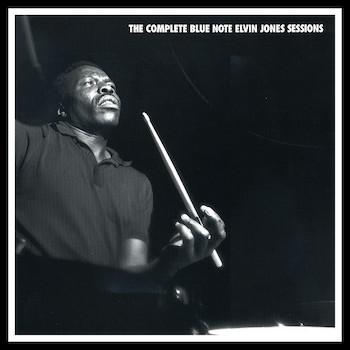
MAX ROACH CALLED HIM “EMPEROR JONES.” HERE’S WHY ELVIN DESERVED THE TITLE.
In any era, only a handful of musicians can lead us over the mountain into a new promised land. Certainly for the contributions he made to the art of drumming, Elvin Jones counts among them.
Evident from his earliest days with John Coltrane was Elvin’s place in the lineage from Max Roach to Art Blakey to Elvin Jones. At every step, you could see greater complexity and a more personal approach to performing in an ensemble. In fact, it is Elvin Jones who finally made the drums an equal part of the ensemble, rather than simply supportive of it.
While others of his day play with confidence and artistic beauty, Elvin plays like he owns rhythm, like it’s his to measure out. You’d watch him play with those long, large arms that could graze the entire kit, pouncing with abandon, and just as easily imagine him embracing the whole drum set and hugging it to him.
Dynamics and tone were his, too.
On record, there is never a tension to his drive, or anything tentative when he lays back and comps. Just firm attack or tender support, as the song warrants and his musicality directs, anywhere on the drum set at any point in time. Call it responsiveness or sensitivity, but his command of dynamics and the way he chooses what to accent are beyond compare.
Elvin is also a great tonal colorist, using every part of the stick and surface he can strike to produce signature sizzles from his cymbals, deep rumbles from his battery of tom-toms, staccato beats or lingering booms from his bass drum. As a soloist, he stands head and shoulders above anyone in the field. There is coherence and compositional control at the same time that he is doling out unexpected and atypical beats like little treats. In fact, it is almost impossible to put into words all he can do.
Loved and respected
Add to it all, he is one of the most loved and respected musicians of his time. Musicians speak openly of his generosity and encouragement; anyone who has ever seen him play live has felt the depth of his humanity flowing from the bandstand. He isn’t just a musician to like. He’s one to feel good liking.
While there are wondrous examples of Elvin’s ability on recordings he made backing Lee Konitz, McCoy Tyner, Wayne Shorter, Sonny Rollins, Ornette Coleman and, of course, John Coltrane, these Mosaic recordings from 1968 to 1973, encompassing the entire output for Blue Note under his name, mark his mature period as a bandleader.
His first two dates from 1968 were with a trio featuring reed man Joe Farrell and, from the Coltrane band, bassist Jimmy Garrison. They led to a larger group the following year (but never released until the late 1970s) with Wilbur Little replacing Garrison, an expanded horn lineup that included Lee Morgan and George Coleman, plus Candido Camero on congas and Miovelito Valles on percussion. Tinkering with the lineup continued later that year, as Elvin dropped the second percussionist and replaced Morgan with Pepper Adams. The following year, Frank Foster joined Elvin’s basic unit for a date.
The new breed.
In later years, a new breed of players took over: Gene Perla, Chick Corea, David Liebman, Steve Grossman, Jan Hammer and Don Alias ushered in a whole new sound in the post-Coltrane era. Other musicians on the dates that followed included guitarists Cornell Dupree and Yoshiaki Masuo, plus a battery of additional percussionists with Omar Clay, Frank Ippolito, Al Duffy, and Patato Valdes significant among them. Brother Thad guested on one set as well.
The length of his career is distinguished by the wide circle of significant musicians Elvin’s band included and the breadth of their ideas. There is no place better than this collection to hear what made him such an important artist, or another set that so clearly documents his role in the music’s evolution.
The set includes a booklet with complete discographical information, a track-by-track analysis and essay by David Liebman, and photographs from the original sessions.
Only the original US Blue Note LP and CD issues are used for the purpose of this discography.
(A) Joe Farrell (ts-1, ss-2, alto fl-3, piccolo-4), Jimmy Garrison (b), Elvin Jones (d). April 8, 1968 The Van Gelder Studio, Englewood Cliffs, NJ
tk.2 Village Greene -1 BST 84282
tk.3 Sweet Little Maia -2 –
tk.8 Reza -1 –
tk.16 For Heaven’s Sake -3 –
tk.17 Keiko’s Birthday March -4 –
tk.24 Gingerbread Boy -1 –
tk.27 Jay-Ree -1 – _____________________________________________________________________
(B) Joe Farrell (ts-1, ss-2, fl-3), Jimmy Garrison (b), Elvin Jones (d). September 6, 1968 The Van Gelder Studio, Englewood Cliffs, NJ
tk.3 What Is This? -2 BST 84305
tk.6 In The Truth -1 –
tk.9 Ascendant -2 –
tk.23 Sometimes Joie -1 –
tk.25 Yesterdays -1 –
tk.26 We’ll Be Together Again -3 – ______________________________________________________________________
(C) Lee Morgan (tp), Joe Farrell (ts-1,ss-2, fl-3,alto fl-4), George Coleman (ts), Wilbur Little (b), Elvin Jones (d), Candido Camero (cga), Miovelito Valles (perc). March 14, 1969 The Van Gelder Studio, Englewood Cliffs, NJ
tk.1 Dido Afrique -1,3 BN-LA 506-2
tk.4 Champagne Baby -2 (omit Valles) –
tk.8 Inner Space -1 (omit Camero, Valles) –
tk.14 Raynay -1 –
tk.18 Once I Loved (O Amor Em Paz) -4 (omit Coleman) – _______________________________________________________________________
(D) Joe Farrell (ts-1,fl-2,English horn-3), George Coleman (ts), Pepper Adams (bari), Wilbur Little (b), Elvin Jones (d), Candido Camero (cga). September 26, 1969 The Van Gelder Studio, Englewood Cliffs, NJ
tk.1 Mr. Jones-1 BST 84331, BN-LA 110
tk.3 Yes -4 – title unknown -1 (omit Camero) rejected
tk.9 Agappe Love-2 BST 84331
tk.12 Whew -1 (omit Adams, Camero) –
tk.14 Agenda -3 – -4 Fred Tompkins (fl), Joe Farrell (bass fl), Wilbur Little (b), Elvin Jones (d). _________________________________________________________________________
(E) Frank Foster (ts-1,alto cl-2), George Coleman (ts), Wilbur Little (b) Elvin Jones (d) Candido Camero (cga, tambourine-2). July 17, 1970 The Van Gelder Studio, Englewood Cliffs, NJ
Simone -1 BST 84361
5/4 Thing -1 –
Ural Stradania -1 –
Yesterdays -1 (omit Camero) –
Shinjitu -2 – __________________________________________________________________________
(F) Frank Foster (ts-1,alto fl-2, alto cl-3), Joe Farrell (ts-4,ss-5), David Liebman (ts-6,ss-7), Gene Perla (b, el b-8), Elvin Jones (d). February 12, 1971 The Van Gelder Studio, Englewood Cliffs, NJ
Slumber -6 (omit Foster, Farrell) BST 84369
Cecilia Is Love -1.4,5.6 –
P. P. Phoenix -2,4,6 –
For All The Other Times -1,4,6 –
Three Card Molly -1,4,7 –
Who’s Afraid… -3,5,7,8 BST 84414 ______________________________________________________________________________
(G) Joe Farrell, David Liebman, Steve Grossman (ts), Jan Hammer (el p), Yoshiaki Masuo (g), Gene Perla (el b), Elvin Jones (d), Don Alias (cga). December 16, 1971 The Van Gelder Studio, Englewood Cliffs, NJ
tk2 ‘Round Town BST 84414
Joe Farrell, David Liebman, Steve Grossman (ss), Jan Hammer (p), Gene Perla (b), Elvin Jones (d), Don Alias (cga,perc). same session
tk.5 Brite Piece BST 84414
Jan Hammer (p), Gene Perla (b), Elvin Jones (d). same session
tk.4 Lungs BST 84414
Joe Farrell (fl), Chick Corea (p), Yoshiaki Masuo (g), Gene Perla (b), Elvin Jones (d). same session
tk.6 A Time For Love BST 84414
Chick Corea, Jan Hammer (el p), Gene Perla (b), Elvin Jones (d), Don Alias (cga). same session
tk.2 Tergiversation BST 84414
Joe Farrell (picc), David Liebman, Steve Grossman (ss), Pepper Adams (bari), Jan Hammer (glockenspiel), Gene Perla (el b), Elvin Jones (d). same session
tk.3 The Children’s Merry-Go-Round March BST 84414
Joe Farrell (ss), David Liebman (ts,ss), Steve Grossman (ts), Pepper Adams (bari), Chick Corea (p), Gene Perla (el b), Elvin Jones (d), Don Alias (cga). same session
tk.2 La Fiesta BST 84414 _____________________________________________________________________
(H) David Liebman, Steve Grossman (ts), Gene Perla (b), Elvin Jones (d). July 12, 1972 The Van Gelder Studio, Englewood Cliffs, NJ
New Breed BN-LA 110
David Liebman (ss), Steve Grossman (ts), Pepper Adams (bari), Jan Hammer (p), Gene Perla (b), Elvin Jones (d),.Frank Ippolito (perc), Carlos Patato Valdes (cga).
same session
What’s Up-That’s It BN-LA 110 ______________________________________________________________________
(I) Steve Grossman (ts), Gene Perla (b), Elvin Jones (d), Albert Duffy (tympani), Frank Ippolito (perc). July 13, 1972 The Van Gelder Studio, Englewood Cliffs, NJ
Soultrane BN-LA 110
Thad Jones (flh), David Liebman (fl), Steve Grossman (ss), Jan Hammer (p), Gene Perla (b), Elvin Jones (d), Albert Duffy (tympani), Frank Ippolito (perc), Carlos Patato Valdes (cga).
same session
One’s Native Place BN-LA 110
Thad Jones (flh), David Liebman, Steve Grossman (ts), Jan Hammer (p), Gene Perla (el b), Elvin Jones (d).
same session
G. G. BN-LA 110
note: This tune was incorrectly listed on BN-LA 110 as Gee Gee. _______________________________________________________________________
(J) David Liebman (fl-1,ss-2,ts-3), Steve Grossman (ss-4,ts-5), Gene Perla (b), Elvin Jones (d). September 9, 1972 Live at The Lighthouse, Hermosa Beach, CA
Set No.1
Brite Piece-2,4,5 CD BN 7-84448-2
New Breed-3,5 BN-LA015-2, CD BN 7-84447-2
Sambra-3,5 BN-LA015-2, CD BN 7-84447-2
My Ship-1,5 BN-LA015-2, CD BN 7-84447-2
Taurus People-3,5 CD BN 7-84447-2
Set No.2
Fancy Free-2,5 BN-LA015-2, CD BN 7-84447-2
I’m A Fool To Want You-3 CD BN 7-84448-2
Sweet Mama-3,5 BN-LA015-2, CD BN 7-84448-2
The Children, Save The Children-2,5 BN-LA015-2, CD BN 7-84448-2
Set No.3
The Children’s Merry-Go-Round March-1,2,3,5 * CD BN 7-84448-2
Small One-1,4 CD BN 7-84447-2
P.P. Phoneix-1,5 rejected
For All The Other Times-3,5 ** CD BN 7-84447-2
* mistitled on CD 7-84448-2 as Children’s Merry-Go-Round
** mistitled on CD 7-84447-2 as For All Those Other Times _____________________________________________________________________________
(K) Frank Foster (ss-1,ts-2), Steve Grossman (ss-3,ts-4) Pepper Adams (bari), Jan Hammer (p-5, el p-6, synth-7), Cornell Dupree (g), Gene Perla (b, el b-8), Elvin Jones (d), Candido Camero (cga), Richie ‘Pablo’ Landrum (perc), Omar Clay (perc, programmable rhythm box), Warren Smith (tympani) July 24, 1973 A & R Recording Studios, NYC
tk.2 The Whims Of Bal -2,3,5,7 BN-LA 506-2 CD BN 4-93385-2
tk.2 The Prime Element -1,3,6,7 – – _____________________________________________________________________________
(L) same personnel as (K) July 25, 1973 A & R Recording Studios, NYC
tk.1 Don’t cry -2,3,5,8 CD BN 4-93385-2
tk.1 Pauke Tanz -2,4,7 –
tk.2 The Unknighted Nations -2,3,6,8 – _____________________________________________________________________________
(M) same personnel as (K) July 26, 1973 A & R Recording Studios, NYC
tk.1 At This Point In Time -2,3,6 BN-LA 506-2 CD BN 4-93385-2
tk.1 Currents/Pollen -2,4,6,7,8 – – ______________________________________________________________________________
Album Index
LPs:
BST 84282 Puttin’ It Together
BST 84305 The Ultimate Elvin Jones
BST 84331 Poly-Currents
BST 84361 Coalition
BST 84369 Genesis
BST 84414 Merry-Go-Round
BN-LA 015-2 Live At The Lighthouse
BN-LA 110 Mr. Jones
BN-LA 506-2 The Prime Element
CDs
CDP 7-84282-2 Puttin’ It Together
CDP 7-84331-2 Poly-Currents
CDP 7-84447-2 Live At The Lighthouse, Volume One
CDP 7-84448-2 Live At The Lighthouse, Volume Two
CDP 4-93385-2 At This Point In Time
Original sessions produced by Duke Pearson (A-B), Francis Wolff (C-F), George Butler (G-J) and Omar Clay (K-M)
Remix supervision: Matt Pierson and David Liebman (J) and Bob Belden (K-M)
Produced for release by Michael Cuscuna
Executive producer: Charlie Lourie
Recording engineer: Rudy Van Gelder (A-I), Dino Lappas (J) and Don Hahn (K-M)
Remix engineers: Rudy Van Gelder (G-I), Malcolm Addey (J) and Peter Doell (K-M)
Mastered using 24-bit analog-to-digital resolution by Ron McMaster, except session J mastered from 16-bit digital mixes.
Masters appear courtesy of Blue Note Records, a division of Capitol Records, Inc.
Producer’s note:
Because much of the material used in this set consists of single sessions that produced entire LPs, we’ve decided, where possible, to retain the original album sequence within a session rather than present it in recorded order of performance. The studios sessions are presented in chronological order, followed by the live Lighthouse session, which occupies the two final discs.
For the sake of repeated listenability, the already lengthy Discs Seven and Eight do not include the stage announcements or the audience singing “Happy Birthday” to Elvin Jones, which appeared on the original double LP issue. The out-of-phase sound on the drums on “Simone” (Disc Four, track three) is on the only surviving tape of this performance. The peak clipping of the bass drum at two points on “For All The Other Times” (Disc Four, track five) is in the original recording.

